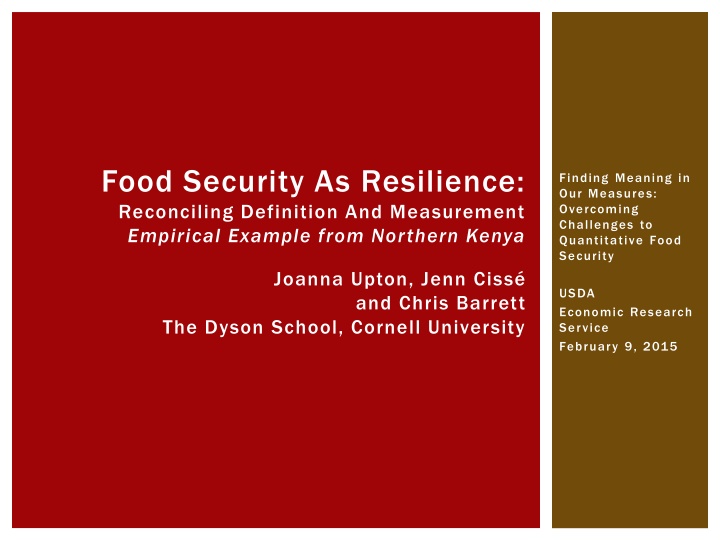
Applying Food Security Measurement in Northern Kenya
Explore the process of measuring food security using empirical examples from Northern Kenya, focusing on the impacts of interventions like Index-Based Livestock Insurance. Learn about setting normative statements and analyzing well-being outcomes to assess resilience and mitigate shocks.
Uploaded on | 1 Views
Download Presentation

Please find below an Image/Link to download the presentation.
The content on the website is provided AS IS for your information and personal use only. It may not be sold, licensed, or shared on other websites without obtaining consent from the author. If you encounter any issues during the download, it is possible that the publisher has removed the file from their server.
You are allowed to download the files provided on this website for personal or commercial use, subject to the condition that they are used lawfully. All files are the property of their respective owners.
The content on the website is provided AS IS for your information and personal use only. It may not be sold, licensed, or shared on other websites without obtaining consent from the author.
E N D
Presentation Transcript
Food Security As Resilience: Reconciling Definition And Measurement Empirical Example from Northern Kenya Finding Meaning in Our Measures: Overcoming Challenges to Quantitative Food Security Joanna Upton, Jenn Ciss and Chris Barrett The Dyson School, Cornell University USDA Economic Research Service February 9, 2015
Motivation Implement the Barrett and Constas (2014) framework following a decomposable poverty measure approach Prevalence of food (in)security, or population with an acceptable probability of falling (below)above a given health/nutrition threshold over time For individuals or any aggregate (entire sample, female- headed households, specific livelihood group ) Satisfies all four axioms of food security measurement Can then be used to measure impacts of shocks or interventions
Measurement To implement, need to make (at least) two normative statements: Level An acceptable standard of well-being, for an individual or population e.g. individual MUAC 125mm; and/or < 10% of population with MUAC < 125mm Probability An acceptable ikelihood of meeting that standard of well-being These must be set by prior research, analysis of context, comparing to other measures, etc.
Empirical Example Northern Kenya (Marsabit) Data collected to assess the impacts of Index Based Livestock Insurance (IBLI) 924 households, tracked annually for five years (2009-2013) Includes data on several well-being outcomes: livestock, expenditure, food consumption, child anthropometry
Empirical Example Follow the empirical procedure piloted by Ciss and Barrett (in production) Choose an outcome and a threshold(s) Mid-upper arm circumference (MUAC) Typically, MUAC thresholds are set in the negative, i.e. admittance to treatment at < 115mm, lower risk of death at > 125mm Using WHO growth guidelines: > -1SD for gender and age appropriate MUAC (with acceptable probability at ) Depending on setting and goals, could use different indicators, thresholds, and/or probabilities
Empirical Example First, estimate the conditional mean MUAC equation, conditioned on: Lagged well-being (MUAC; squared and cubed to capture path dynamics) Livelihoods and risk factors, here livestock mortality and livestock death strike point (based on NDVI) Demographics (age, sex, and education level of household head) Child sex and supplemental feeding status
Empirical Example Regression of MUAC on (selected) covariates: (1) (1) MUAC MUAC -7.031*** 0.503*** -0.011*** -0.379* -0.105 0.032*** -0.054* -0.412*** -0.024 VARIABLES VARIABLES SE SE MUAC lag MUAC lag2 MUAC lag3 Livestock strike point Female hh head HH head education Dependency ratio Supp. feeding Girl Observations (2.314) (0.168) (0.004) (0.197) (0.066) (0.009) (0.030) (0.069) (0.054) 1,714
Empirical Example Square residuals and estimate the conditional variance, as a function of the same regressors Here, assume a normal distribution (such that the mean and variance fully describe the child s conditional MUAC distribution) Use the mean and variance to estimate resilience Individual probabilities of MUAC > -1SD (for age and gender), conditional on lags & other characteristics Individual-level PDFs, with value (above cut-off) between 0 and 1
Empirical Example Explore which characteristics are associated with food security (MUAC) resilience: VARIABLES VARIABLES MUAC lag MUAC lag (^2) MUAC lag (^3) Livestock strike point Female hh head HH head education Dependency ratio Supp. feeding Girl Observations (1) (1) MUAC MUAC -7.031*** 0.503*** -0.011*** -0.379* -0.105 0.032*** -0.054* -0.412*** -0.024 SE SE (3) Resilience (3) Resilience -2.501*** 0.117*** -0.004*** -0.213*** -0.063*** .0112*** -0.011* 0.381*** 0.0211*** 1,714 SE SE (2.314) (0.168) (0.004) (0.197) (0.066) (0.009) (0.030) (0.069) (0.054) (0.185) (0.013) (0.0003) (0.024) (0.009) (0.001) (0.004) (0.008) (0.007)
Resilience Aggregation We can, by construction, aggregate the resilience measure for different groups, by setting an accepted probability threshold Set to (i.e. acceptable threshold is 66.7% chance of falling above the -1 SD MUAC threshold) Note, can set R=0 (headcount), R=1 (gap), R=2 (gap2or depth); here we calculate the resilience headcount
Resilience Aggregation Across periods, divided by gender of household head:
Resilience Aggregation Across periods, divided by education level of household head:
Summary & Next Steps The Barrett and Constas (2014) resilience theory encapsulates the core dimensions of food security Stability over time, responses to shocks Individuals and aggregate groups of interest and it can be empirically implemented Condition on access (helps to illuminate mechanisms) Choice of specific outcome to best reflect food security in a given context Results may be sensitive to the choice of outcome indicator Reflects all four of the axioms for measurement of food security
Summary & Next Steps We can implement this measure with panel data that is routinely collected In some cases with minor adjustments or additions Need further attention to data on shocks and stressors Significant work ahead, in applying this metric to different settings and problems Ideally also in improving (and institutionalizing) conducive data collection mechanisms
Thank you Questions and comments (more than) welcome
